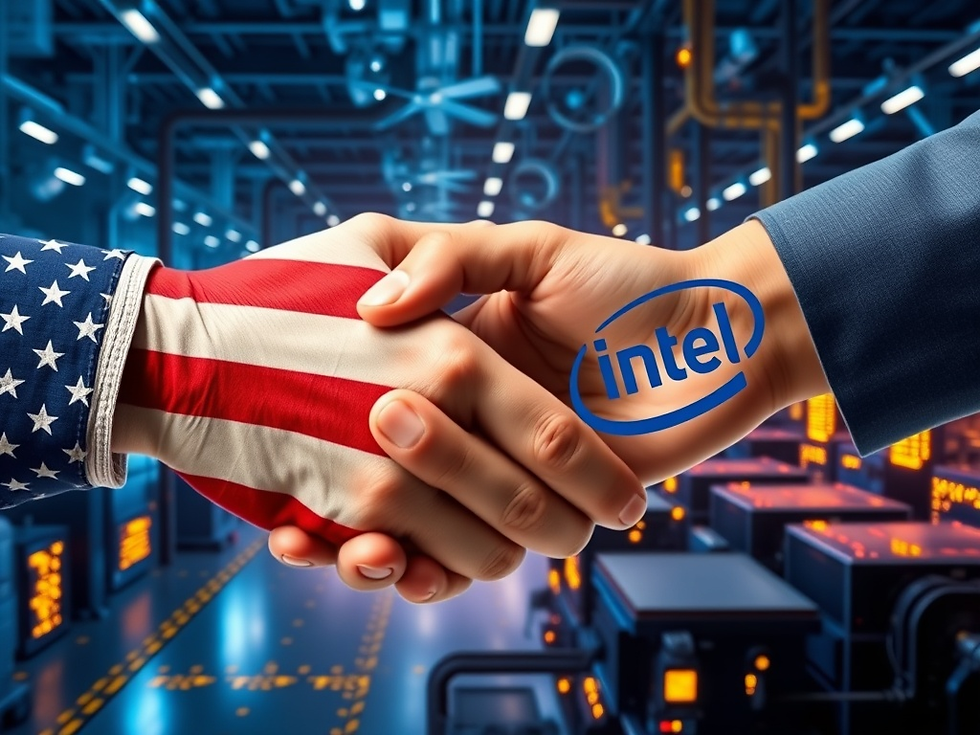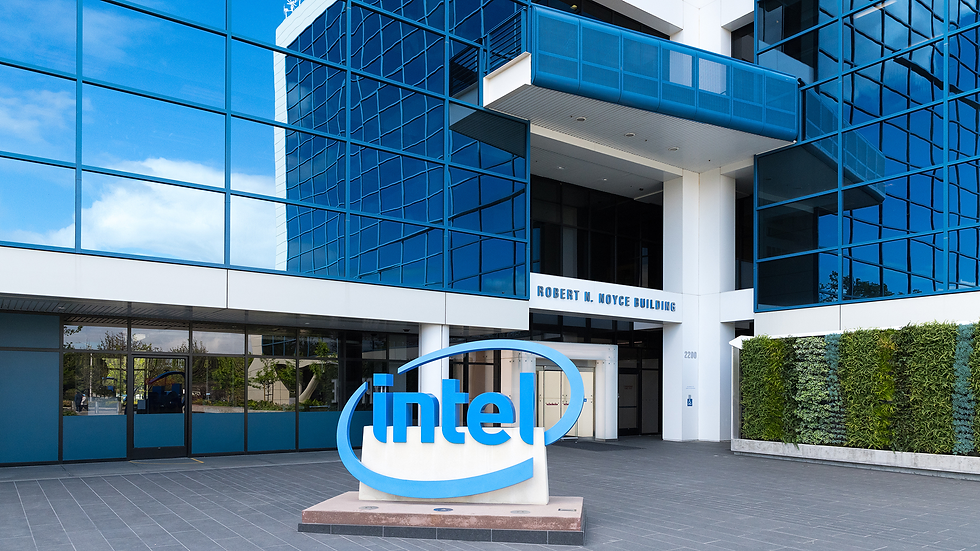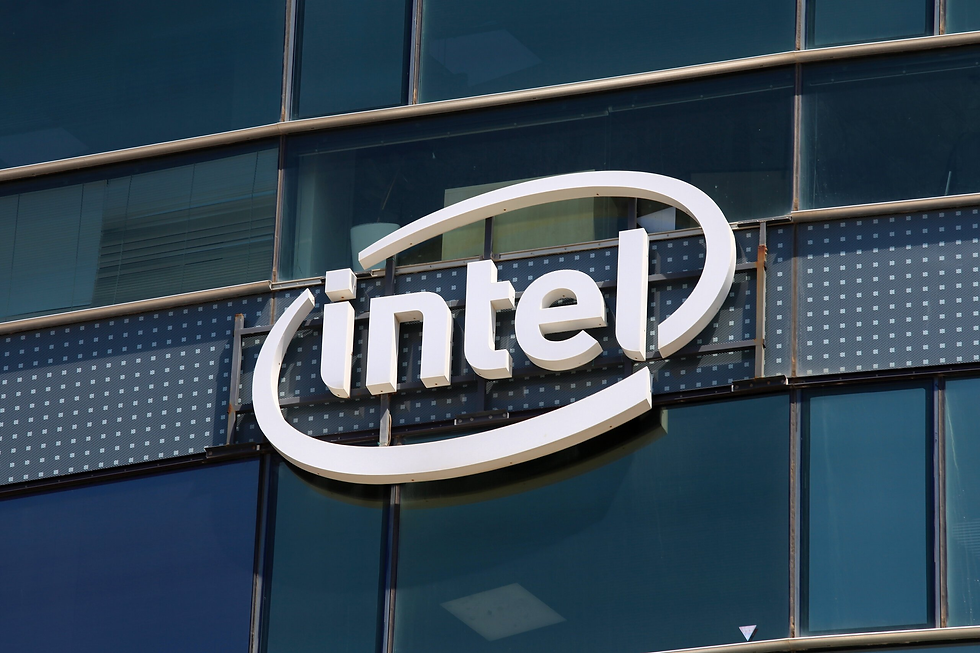Government Investment in Intel: Lifeline or Long-Term Risk?
- Ethan Carter

- Aug 16
- 9 min read

Government investment in Intel refers to the U.S. federal government's involvement in funding and potentially taking an equity stake in Intel Corporation, one of the world’s largest semiconductor manufacturers. This initiative is primarily driven by the CHIPS and Science Act, a landmark piece of legislation aimed at revitalizing domestic semiconductor production to secure supply chains, foster innovation, and bolster national security. The current public discussion centers on whether government funding and possible ownership represent a vital lifeline for Intel's future competitiveness or a long-term risk that could entangle the company in political and regulatory complexities.
The stakes are high. Semiconductors underpin nearly every modern technology—from smartphones and cars to military systems and artificial intelligence platforms—making domestic semiconductor capacity critical for economic stability and national security. Intel’s position as a leading chipmaker has faced challenges in recent years, prompting calls for government support to sustain its global competitiveness. At the same time, any government stake in Intel raises questions about market dynamics, investor confidence, and the potential for political interference.
This article explores these issues in depth. We begin with the geopolitical context driving government investment in semiconductors and Intel's specific challenges. Next, we examine the CHIPS Act funding Intel has received—the terms, amounts, and deployment plans. We then analyze the strategic benefits of this partnership, followed by an honest assessment of governance risks. Market reactions are reviewed before concluding with a FAQ section and actionable insights on balancing the lifeline against long-term risks.
Background: The Context for Government Investment in Intel

Semiconductor Geopolitics and Supply-Chain Concerns
The global semiconductor industry is increasingly viewed through a geopolitical lens. Governments worldwide prioritize domestic chip production because semiconductors are foundational to modern economies and military capabilities. Supply disruptions during the COVID-19 pandemic exposed vulnerabilities in global supply chains, especially as much chip manufacturing is concentrated in East Asia. The U.S. government’s push for increased domestic capacity aims to reduce dependence on foreign fabs, ensuring resilience in critical sectors such as defense, automotive, and information technology.
This rising strategic importance has led to unprecedented levels of government investment in semiconductors. The U.S. has committed billions to incentivize chipmakers like Intel to expand production within its borders. According to Technology Magazine, this investment is a direct response to growing concerns over supply-chain fragility and geopolitical competition, particularly with China. By fostering a robust domestic semiconductor ecosystem, policymakers hope to secure technological leadership while mitigating risks posed by global trade tensions.
Intel’s Market Position, R&D Profile, and Historical Challenges
Intel remains a heavyweight in the semiconductor market with a storied history of innovation and dominance in microprocessors powering personal computers and data centers. Its Intel market position is characterized by deep integration across chip design, manufacturing, and research, supported by one of the largest corporate R&D budgets globally. However, recent years have seen Intel falter in its race to advanced process nodes compared to competitors like TSMC and Samsung.
This competitive gap has led to missed product cycles and eroded market share, prompting calls for intervention to restore Intel’s technological leadership. As detailed in an analysis of Intel’s dominance, the company’s challenges stem from management missteps, delayed fab expansions, and rising capital costs for next-generation manufacturing. These difficulties underscore the rationale for Intel R&D support through public-private partnerships designed to accelerate innovation and production capacity.
Academic View — Public vs Private R&D Complementarity
Academic research strongly supports the concept of public-private R&D complementarity, where government funding can enhance private sector innovation rather than crowd it out. Studies published on arXiv demonstrate that public investments often provide foundational knowledge, shared infrastructure, or risk capital that firms like Intel can leverage to boost their own research productivity.
This evidence forms a key part of the policy rationale behind the CHIPS Act: targeted government incentives can catalyze advanced semiconductor technologies that benefit both industry competitiveness and national interests. By strategically complementing private Intel R&D efforts with public resources, the U.S. hopes to rekindle innovation momentum while preserving market-driven agility.
The CHIPS Funding for Intel: Terms, Amounts, and Deployment

Summary of the CHIPS and Science Act Award to Intel
Under the CHIPS and Science Act, Intel was awarded significant financial incentives designed to spur domestic semiconductor manufacturing. The U.S. Department of Commerce announced a comprehensive package including grants and loans totaling several billion dollars aimed at expanding Intel’s fabs across multiple states—including Arizona, New Mexico, Ohio, and Oregon.
This CHIPS Act funding Intel is structured with both direct grants and low-interest loans contingent on meeting specific milestones. The Commerce Department press release highlighted that these funds aim to catalyze cutting-edge fabrication facilities capable of producing advanced-node chips critical for sectors ranging from consumer electronics to defense.
Intel’s Stated Use of Funds: Manufacturing, R&D, and Facilities Expansion
Intel has publicly outlined plans for deploying these funds across several strategic priorities. The company intends to use Intel funding for manufacturing to build new fabs equipped with state-of-the-art lithography tools enabling smaller transistors and higher yields. Additionally, these investments will support Intel R&D investment CHIPS initiatives focused on next-generation chip architectures and materials science.
Expansion efforts also include workforce development programs to train technicians and engineers essential for operating complex fabs. As detailed in the Intel newsroom on CHIPS, this multifaceted approach aims not only to scale production but also to strengthen the entire semiconductor ecosystem in key U.S. regions.
Implementation Timeline, Conditionality, and Regulatory Oversight
The CHIPS funding comes with strict conditions shaping how Intel can deploy resources. Typical CHIPS Act conditions include phased grant disbursements tied to project milestones like facility completion dates and production ramp-ups. There are also transparency requirements under Freedom of Information Act (FOIA) provisions alongside national security-related restrictions limiting certain exports or partnerships.
According to Technology Magazine, these conditions create accountability mechanisms ensuring public funds advance strategic goals rather than subsidize routine business operations. The overall Intel project timeline anticipates several years before full-scale production capacity is achieved, emphasizing sustained collaboration between government oversight bodies and corporate management.
Key insight: The CHIPS Act funding framework balances generous financial support with safeguards designed to align Intel’s manufacturing expansion with broader U.S. economic and security objectives.
Strategic Benefits: How Government Investment Could Strengthen Intel and US Tech

Accelerating Domestic Advanced-Node Manufacturing Capacity
One of the most immediate benefits of government investment in Intel lies in lowering the capital barriers that impede building advanced-node fabs—those manufacturing chips with transistors measured in single-digit nanometers. Such facilities can cost upwards of $20 billion each and require years to become operational.
By sharing these costs through CHIPS funding, this investment accelerates time-to-scale for fabs capable of producing chips critical for cutting-edge applications like automotive electronics, defense systems, and AI data centers reliant on secure domestic supply chains. As highlighted by Intel’s own statements on CHIPS-related expansion, this boost enhances America’s ability to compete globally while reducing reliance on foreign foundries vulnerable to geopolitical disruptions.
Amplifying R&D, Talent, and Technology Spillovers
Public funding also amplifies Intel R&D spillovers by enabling larger-scale research projects that might be impractical solely under private financing constraints. This infusion attracts specialized talent across engineering disciplines while fostering collaborations with universities and startups throughout the U.S.
The academic consensus on public-private R&D complementarity underscores how such partnerships generate positive externalities—knowledge diffusion beyond Intel itself that fuels innovation clusters enhancing the entire technology ecosystem. Reinforcing this dynamic helps secure long-term U.S. leadership not just in chip fabrication but also in software tools, design methodologies, and materials innovation.
National Security and Supply-Chain Resilience Use Cases
From a national security perspective, strengthening Intel through government investment directly addresses vulnerabilities exposed by reliance on offshore fabs subject to export controls or political instability. Domestic fabs ensure a trusted supply of national security chips used in military hardware, communications infrastructure, and critical logistics systems.
Moreover, enhancing supply-chain resilience Intel supports mitigates risks from global disruptions such as pandemics or trade conflicts by localizing key portions of semiconductor value chains closer to end users and policymakers’ oversight. This strategic capability aligns with broader U.S. defense procurement goals aiming for technological self-sufficiency amid intensifying great-power competition.
Risks and Governance: Is a Government Stake in Intel a Long-Term Risk?

Economic and Market Risks of Partial Government Ownership
While government stake in Intel could provide much-needed capital support, it also introduces potential economic risks that warrant careful consideration. Equity participation by public entities may distort traditional market incentives by prioritizing political or strategic goals over shareholder value maximization.
The Financial Times warns that such public ownership effects might reduce management’s willingness or ability to make bold innovation bets if constrained by government oversight or conflicting agendas. Market valuations could be affected negatively if investors perceive increased political interference or uncertainty regarding corporate governance autonomy.
Political, Regulatory, and Foreign Policy Constraints
A government stake inevitably brings heightened political oversight Intel, introducing regulatory constraints that may limit commercial flexibility. Export controls mandated by U.S. foreign policy may restrict sales into lucrative markets like China or necessitate compliance with complex procurement rules favoring government priorities.
As Reuters reports (U.S. weighs taking stake in Intel), these constraints could complicate global operations by forcing difficult choices between market access and strategic alignment. Balancing these tensions requires nuanced governance structures capable of preserving Intel’s competitive edge while meeting national security demands.
Technical and Innovation Trade-Offs from Conditional Funding
Conditional grants under programs like CHIPS may reshape R&D direction Intel, emphasizing certain technology nodes or product lines at the expense of others based on policy priorities rather than pure market signals. This can introduce innovation trade-offs CHIPS funding, where bureaucratic oversight potentially slows iterative experimentation vital for breakthrough developments.
Academic literature on policy impact on technological performance suggests that while targeted funding boosts specific areas, excessive conditionality risks distorting research agendas or fostering risk aversion among corporate scientists wary of meeting prescriptive mandates versus pursuing disruptive innovation paths.
Balancing act: The challenge lies in designing governance frameworks that preserve operational independence while ensuring alignment with strategic public interests.
Market Reaction and Financial Impact: Investor Sentiment After Government Involvement

Immediate Market Responses to Stake and Funding Announcements
News of substantial CHIPS Act funding Intel awards triggered mixed reactions from investors—initial optimism about renewed growth prospects tempered by concerns over increased government involvement. According to Financial Times coverage, Intel’s stock experienced volatility around announcements reflecting uncertainty about long-term implications for valuation.
Analysts acknowledged that while capital injections offer short-term relief supporting expansion projects, questions remain about how governance changes might influence future earnings multiples.
Analyst Scenarios — Upside vs Downside Valuation Impacts
Industry experts present diverging scenarios about the valuation impact from government funding:
Scenario | Description | Potential Impact |
|---|---|---|
Accelerated Revenue Growth | Funding enables faster fab build-out plus R&D breakthroughs driving new product launches | Stock price appreciation; improved investor sentiment |
Governance Risk Discount | Political interference dampens innovation incentives; export restrictions limit markets | Valuation multipliers compressed; stock under pressure |
Rescue Investment Proposal | Former executives suggest ~$40B large-scale government-backed investment for turnaround | Potential stabilization but increased public scrutiny |
A Tom’s Hardware article highlights calls from insiders advocating bold government-supported plans as necessary to restore competitiveness but warns these come with trade-offs around corporate autonomy.
Cross-Border and Geopolitical Investor Considerations
Investor sentiment also reflects broader geopolitical uncertainties influencing multinational operations. With U.S.–China tensions escalating, export controls embedded within CHIPS funding increase geopolitical risk Intel, prompting some foreign investors to reassess exposure given potential supply-chain bifurcation or regulatory hurdles.
Reuters notes that these dynamics add complexity not only for valuation models but also for strategic partnerships spanning borders—factors critical for investors weighing long-term growth versus regulatory headwinds.
FAQ and Conclusions: Actionable Takeaways and Forward-Looking Analysis

FAQ — Likely Reader Questions
Q1: Is the CHIPS funding a subsidy or an investment? A1: The CHIPS Act combines grants (non-repayable subsidies) with loans requiring repayment under specific terms. Both come with conditions tied to project milestones ensuring funds advance strategic manufacturing goals rather than routine expenses.
Q2: Would a government stake mean the U.S. controls Intel’s product roadmap? A2: While government equity increases oversight, practical governance structures aim to preserve management autonomy over commercial decisions. However, strategic alignment on national security priorities may influence certain product areas.
Q3: How does public funding impact long-term innovation? A3: Studies show public funding complements private R&D efforts by providing foundational research support and infrastructure that enhances overall technological performance.
Q4: What should investors watch next? A4: Key milestones include grant disbursement dates, regulatory filings related to equity stakes or export controls, production ramp announcements from new fabs, and official statements from both Intel and government agencies.
Q5: Can government involvement affect global partnerships? A5: Yes—export controls linked to government funding may restrict collaborations or sales in certain countries due to geopolitical considerations.
Actionable Conclusions — Lifeline vs Long-Term Risk
The evidence suggests CHIPS Act funding Intel offers a crucial lifeline enabling accelerated fab construction, expanded R&D capabilities, and enhanced supply-chain resilience vital for U.S. economic security. However, introducing a direct government stake in Intel raises long-term risks related to governance complexities, potential political interference, and innovation trade-offs.
To maximize benefits while mitigating risks:
Implement clear conditionality linking funds strictly to performance milestones.
Enforce sunset clauses limiting duration of government ownership.
Ensure independent oversight boards incorporating industry expertise.
Develop robust metrics monitoring technology performance aligned with strategic goals.
Balanced governance safeguards under CHIPS will be essential to preserve Intel’s entrepreneurial agility while securing national interests.
Forward-Looking Signals to Monitor (6–9 Months)
Stakeholders should track:
Disbursement milestones for CHIPS grants and loans.
Announcements regarding fab construction progress across Arizona, New Mexico, Ohio, Oregon.
Congressional debates or regulatory filings concerning potential equity stakes.
Coverage from Financial Times or Reuters updating market sentiment.
Any formal negotiations around U.S. government ownership shares.
Academic evaluations assessing early impacts on innovation dynamics.
This watchlist will illuminate the evolving future of Intel government investment while guiding informed decisions by investors, policymakers, and industry observers alike.
Government investment in Intel represents one of the most consequential industrial policy experiments of recent decades—balancing urgent economic imperatives against complex governance challenges as America seeks semiconductor leadership in a competitive global landscape.


